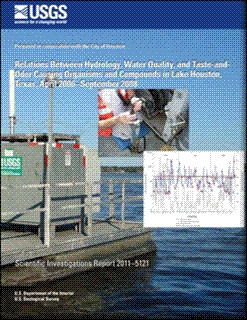
Product Details
- Product Number
- 317993
- Series
- SIR-2011-5121
- Scale
- NO SCALE
- Alternate ID
- SIR-2011-5121
- ISBN
- 978-1-4113-3221-8
- Authors
- JENNIFER L GRAHAM
- Version Date
- 01/01/2011
- Regions
- TX
- Countries
- USA
- Media
- Paper
- Format
- Bound
Additional Details
- Description
- Abstract Lake Houston is a surface-water-supply reservoir and an important recreational resource for the city of Houston, Texas. Growing concerns over water quality in Lake Houston prompted a detailed assessment of water quality in the reservoir. The assessment focused on water-quality constituents that affect the aesthetic quality of drinking water. The hydrologic and water-quality conditions influencing the occurrence of taste-and-odor causing organisms and compounds in Lake Houston were assessed using discrete and continuously monitored water-quality data collected during April 2006–September 2008. The hydrology of Lake Houston is characterized by rapidly changing conditions. During inflow events, water residence time can change by orders of magnitude within a matter of hours. Likewise, the reservoir can stratify and destratify over a period of several hours, even during non-summer and at relatively short water residence times, given extended periods with warm temperatures and little wind. The rapidly changing hydrology likely influences all other aspects of water quality in Lake Houston, including the occurrence of taste-and-odor causing organisms and compounds. Water quality in Lake Houston varied with respect to season and water residence time but typically was indicative of turbid, eutrophic to hypereutrophic conditions. In general, turbidity and nutrient concentrations were largest during non-summer (October–May) and when water residence times were relatively short (less than 100 days), which reflects the influence of inflow events on water-quality conditions. Large inflow events can cause substantial changes in water-quality conditions over relatively short periods of time (hours). The taste-and-odor causing organisms cyanobacteria and actinomycetes bacteria were always present in Lake Houston. Cyanobacterial biovolume was largest during summer (June–September) and when water residence time was greater than 100 days. Annual maxima in cyanobacterial biovolume occurred during July-September of each year, when temperatures were larger than 27 degrees Celsius and water residence times were longer than 400 days. In contrast, actinomycetes bacteria were most abundant during non-summer and when water residence times were less than 100 days, reflecting the close association between these organisms and transport of suspended sediments. Geosmin and 2-methylisoborneol are the taste-and-odor causing compounds most commonly produced by cyanobacteria and actinomycetes bacteria. Geosmin was detected more frequently (62 percent of samples) than 2-methylisoborneol (29 percent of samples) in Lake Houston. Geosmin exceeded the human detection threshold (10 nanograms per liter) only once during the study period and 2-methylisoborneol exceeded the human detection threshold twice. Manganese is a naturally occurring trace element that can occasionally cause taste-and-odor problems in drinking water. Manganese concentrations exceeded the human detection threshold (about 50 micrograms per liter) in about 50 percent of samples collected near the surface and 84 percent of samples collected near the bottom. The cyanotoxin microcystin was detected relatively infrequently (16 percent of samples) and at small concentrations (less than or equal to 0.2 micrograms per liter). The abundance of the taste-and-odor causing organisms cyanobacteria and actinomycetes bacteria in Lake Houston was coupled with inflow events and subsequent changes in water-quality conditions. Cyanobacterial biovolume (biomass) in Lake Houston was largest during warm periods with little inflow and relatively small turbidity values. In contrast, actinomycetes bacteria were most abundant following inflow events when turbidity was relatively large. Severe taste-and-odor problems were not observed during the study period, precluding quantification of the hydrologic and water-quality conditions associated with large concentrations of taste-and-odor causing compounds and development of predictive models. Reservoir inflow (water residence time) and turbidity, variables related to the abundance of potential taste-and-odor causing organisms, are currently (2011) continuously measured in Lake Houston, and predictive models could be developed in the future when the hydrologic and water-quality conditions associated with taste-and-odor problems have been better quantified. Seasonal and water residence time influences on water-quality conditions altered relations between hydrologic and water-quality conditions and taste-and-odor causing organisms and compounds. Future data collection and development of predictive models need to account for the variability associated with season and water residence time.
- Survey Date
- 2011
- Print Date
- 2011
- Height In Inches
- 11.000
- Length In Inches
- 8.500
- Two Sided
- Yes
- Pieces
- 1
- Languages
- English
Related Items




